|
[VIEWED 407923
TIMES]
|
SAVE! for ease of future access.
|
|
|
|
|
|
JPEG

Please log in to subscribe to JPEG's postings.
Posted on 04-18-09 9:46
AM
Reply
[Subscribe]
|
Login in to Rate this Post:
1  ?
?  Liked by
Liked by
|
| |
Last edited: 11-Jun-09 09:12 AM
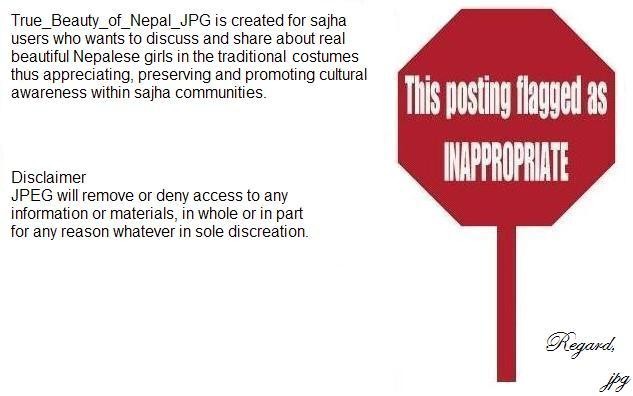
|
| |
|
|
|
|
JPEG

Please log in to subscribe to JPEG's postings.
Posted on 06-17-09 7:13
PM
Reply
[Subscribe]
|
Login in to Rate this Post:
0  ?
? 
|
| |
teamlogo 80% Yes. Just appreciate please. No Question Ask! Limbu ni beauty
Last edited: 17-Jun-09 07:17 PM
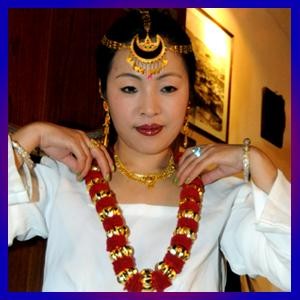
|
| |
|
|
npJHILKE

Please log in to subscribe to npJHILKE's postings.
Posted on 06-17-09 8:23
PM
Reply
[Subscribe]
|
Login in to Rate this Post:
0  ?
? 
|
| |
Nice pictures! Keep it up posting.
|
| |
|
|
JPEG

Please log in to subscribe to JPEG's postings.
Posted on 06-18-09 9:37
AM
Reply
[Subscribe]
|
Login in to Rate this Post:
0  ?
? 
|
| |
Chepang ni beauty. One of the most backward indigenous nationalities of Nepal, the Chepangs inhabit in the remote and sparse contours, outback and rolling precipices of the districts of Makwanpur, Chitwan, Gorkha and Dhading. They claim that they belong to Kirati group of people. Hence according to the study so far, the scholars have agreed that Chepangs are the offshoots of Kirats. Like the Kusundas, the Chepangs are mostly hunters and gatherers. Their subsistence economy is based on forest resources. They are emerging as horticulturists also. Being landless, 95 percent of them forage for tubers and for food. Today it is stated that they became landless mostly due to lack of documentary evidences to claim land ownership. They also had a system of kipat, communal ownership of land till the first half of the 19th century till this right was taken away during the 104-years of Rana rule. "The most devastating events in this period was confiscation of traditional Kipat land tenure and re-distribution of land to state elites, i.e the ruling class through, Birta and Jagir land tenures and exploitation of indigenous peoples and Dalits through forced free labor such as jahra, rakam, beth and begar."(Regmi 1999) Less then 15 percent Chepangs are literates and almost 90 percent of them are leading life under utter poverty. Hence NEFIN has categorize them in Highly Marginalized Group. These days, there are some projects run for Chepangs, but are not becoming really effective so far. School enrollment ratio of school going children is still very low and drop out rate is very high. The census 2001 has revealed that the population of Chepand is 52,237. The Chepangs have their own language, which belongs to the Tibeto-Burman family. According to Schafer and Toba, the Chepang language is close to the languages of Thami and Hayu (Dhungel, BS2051: 42). The naming ceremony among the Chepangs takes place nine days after the birth of the child. During the ceremony the Chepang shaman (Pande) reads sacred texts over a cock, a hen, thread coloured with turmeric, thin roti (bread) made of maize flour, totala flower, egg, etc and takes them outside for worship. The child and its mother are tied with the thread, and the child is given a name. Alcohol is required during marriage. The boy's side must obtain the consent of the girl's side before or after marriage. The Chepangs mostly bury their dead. The dead body is bathed and new clothes and garlands of flowers are put on the body and wrapped with burial cloth. A box is made of the barks of sal, in which the dead body is kept and buried. Pollution is observed by some for three days and by some for nine and also thirteen days. The death rites are carried out by the shaman (Praja, BS2056). After the recitation of sacred incantations, Chepangs collectively go to hunt and fish. They worship the bows and arrows used in hunting once every year. When i had a chance to meet this group, i found out that almost all the members of Chepang, an indigenous community in Makawanpur district are deprived of citizenship, their birthrights and the land ownership certificates despite their several attempts. In context to the national level, 85 per cent of the Chepangs do not possess citizenship cards, according to concerned sources. Then i remember this quote.
“timi afnai gharma afain baas namaga)â€
(“You don’t ask for a shelter in your own homeâ€) -- Bhupal Rai (2000:4)
Points to be taken:Thami belongs to the Kirat family. It is believed that Thami was left behind when the Kirat people moved to the east of kathmandu after the end of Kirat dynasty. In the same way scholars argued that Chepang and many Newaris caste originated from Kirat people. Regmi, speculates that the early Newars may have an ancestry connected with both the Kiranti and the Lichhavis. Prof. Sudarshan Raj Tiwari(The Temple of the Kirata Nepal) states that some of the Newar Jaats of Kathmandu, particularly the Prajapatis(KumvahkaraKumharaKumhale), Maharjans, Dongols, Nayos, Tepehoys, etc., have been said to be descendents of the Kiratas. The similarity in place names of Tistung-Palung-Chitlang to the south of Chandragiri hills, now inhabited by the Hale and Gwa caste groups of Newars, and Chepang area, as well as the linguistic relations between the Chepangs, Newars and Kirats indicate they could have common ancestry and could be descendents of the Nagas. The Newar name for Patan, Yala, is believed to originate from the Kirat king Yellung or Yalamba, the alleged founder of the dynasty and the city. (Tiwari,2001)

|
| |
|
|
JPEG

Please log in to subscribe to JPEG's postings.
Posted on 06-18-09 10:55
AM
Reply
[Subscribe]
|
Login in to Rate this Post:
0  ?
? 
|
| |
Beautiful Nepali Beauties from JPG album

|
| |
|
|
JPEG

Please log in to subscribe to JPEG's postings.
Posted on 06-18-09 11:44
AM
Reply
[Subscribe]
|
Login in to Rate this Post:
0  ?
? 
|
| |
Beauty_of_Never_End_Peace_And_Love of Tharu ni dressed for the Sakiya dance, to celebrate the end of the harvest. For the last one hundred years peoples around the world have been fascinated by Nepal because of its magnificent mountains, the towering Himalayas. Closed off from the outside world by its potentates, this kingdom lived in secluded splendor until the 1950's, when its doors officially opened to the outside world. The isolation of the Tharu in the Tarai was even more complete: living in villages located in the malaria-infested jungles of the Gangetic plains, they rarely encountered outsiders. Over the millennia they developed a unique culture free from the influence of adjacent India, or from the mountain groups of Nepal. Only recently, when DDT eradicated the malaria, did the Tarai begin to attract settlers seeking to escape the harsh and little productive lands of their own ancestors. The month of November bears a special significance for Terai dwellers in Nepal. Usually regarded as the month of harvest it brings with it loads of joy to all. The fields, villages and streets are all filled with the aroma of freshly cut paddy. The granaries are generally full with newly harvested rice and the aroma of new rice wafts away from every kitchen in the villages. The children await the harvest with much eagerness. After school hours or taking turns to herd the cattle and goats they glean rice from fields. Scouring the fields they search the rice stalks missed by the reapers. The collected rice is bartered with the petty sellers offering local delicacies (jilebi, kachari, and sweets). The rice is often sold in shops and the sum is saved to spend in the melas (village fetes) and haats (make-shift markets). Meanwhile the farmers prepare jhuttis – artistic form of rice stalk sheaf weaving. Especially, the Tharus prepare jhuttis for each variety of rice they harvest. The jhuttis are hung high on the meh (the bamboo pole to which the oxen are tethered while threshing rice). Points to be taken:According to Nepali author Subodh Kumar Singh, a series of invasions by the other races,from north India across the border and from hills and mountains of Nepal, eroded the influence of the indigenous Tharus. In 1854 Jung Bahadur, the first Rana prime minister of Nepal, developed the Mulki Ain, a codification of Nepal's indigenous legal system which divided society into a system of castes. The Tharus were placed at next to the bottom(lowest touchable,above untouchables) of the social hierarchy. Their land was taken away, disrupting their community and displacing the people. In the 1950s, World Health Organization helped the Nepalese government eradicate malaria in the Terai region. This resulted in immigration of people from other areas to claim the fertile land, making many Tharus virtual slaves of the new landowners and developing the kamaiya system of bonding generations of Tharus families to labour. ~ "The Great Sons of the Tharus: Sakyamuni Buddha and Emperor Asoka" by Subodh Kumar Singh

|
| |
|
|
JPEG

Please log in to subscribe to JPEG's postings.
Posted on 06-18-09 1:04
PM
Reply
[Subscribe]
|
Login in to Rate this Post:
0  ?
? 
|
| |
Yolmo ni beauties at Yhaye cultural program taken by JPG Description of Yhaye. As per the information received from various elders and from those who had the experience of Yhaye performance, Yhaye is a traditional performance which is performed by a group of people from a village and go to every household for the request of some donations either cash or corn on certain special occasion. The request is made by reciting traditional Yhaye lyric followed by Yhaye……….. Yhaye in repeated form. The lyric contains the historical facts stating the formation procedures of the present world and the planet systems. It also contains the blessings and well wishes towards all the sentient beings. The amount collected from Yhaye is used for social welfare activities such as renovation of trails, construction of ponds and various preservation activities. The time period of Yhaye performance varies from village to village and on the occasion the Yhaye is performed.

|
| |
|
|
JPEG

Please log in to subscribe to JPEG's postings.
Posted on 06-18-09 2:55
PM
Reply
[Subscribe]
|
Login in to Rate this Post:
0  ?
? 
|
| |
Thakali nis beauty. The emergence of name Thakali is relatively new. The name Thakali start to appear in the beginning of the twelfth century. It is no doubt that Thakali migrated from the Tibetan plateau along with Lepcha, Sherpas, Tamang, Yolmo people. The History of the Kirat People states that the origin of the Kirat viz Tibeto-Burmese people can be traced back in combination of three races known by the names of Khambongbas(Khambos), the Tangsangthas(Mongols) and the Munaphens(Chinese). The Khambos were the first immigrants to this Himalayan region. The Tangsangthas and the Munaphens people came in later periods and intermingled with the Khambos to form a bigger human race. Scholar H.C. Ray Chowdhary(The Political History of Ancient India) states "In India, Kirat people occupied the regions from Himachal Pradesh to Assam in the north and from Manipur to Chittangong in south-east." His work is compiled in the history of the Kirat people. The stronghold of the Thakalis is Thak Khola in Mustang District. They have their own language, which belongs to the Tibeto-Burman family, and is similar to Gurung (Tamu) and Tamang languages. Thakalis have four major clans - Chhyoki (Gauchan), Salki (Tulachan), Dhimchen (Sherchan), and Bhurki (Bhattachan) - Lha Phewa is a major festival of the Thakalis, which is renowned as a 12-year cyclic fair. Thakalis adhere both to Bon and Buddhism. Their Toranlha festival coincides with the Fagu Purnima. hakalis have a language of their own. It belongs to the Tibeto-Burman family of languages. This language is similar to the languages of Tamang, Gurung and Chhantyals. Dhom (Jhankri) performs the christening of a newborn. Like in many other indigenous peoples and nationalities, the maternal uncle has a prominent role in the first haircut of a child. Thakalis have a traditional marriage rite called Haji or marriage by capture in which the boy captures the girl he loves with her consent. Death rites are performed through Dhom method if available and if not available through Lama method. Thakalis have converted from Bon religion to Buddhism. Thakalis have an ancient political, judicial, social and economic institution which implements the rules, laws and regulations made by the thirteen Mukhiyas (chieftains) of the thirteen thasang villages of Thakalis. It settles disputes relating to petty quarrels, theft, robbery and other cases, protects forests and controls social evils and promotes customs like Dhukor (Bhattachan, BS2056).Although the traditional occupations of Thakalis are agriculture and animal husbandry, they are famous today for trade and business. Their success stories in the economic field are illustrious and worth imitating by all. work referenced: The Thakali by Michael Vinding Himalayan anthropology by James F. Fisher The History of the Kirat People, 2003
Last edited: 18-Jun-09 02:56 PM

|
| |
|
|
JPEG

Please log in to subscribe to JPEG's postings.
Posted on 06-18-09 5:47
PM
Reply
[Subscribe]
|
Login in to Rate this Post:
0  ?
? 
|
| |
Baral ni beauty JPG by JPG

|
| |
|
|
JPEG

Please log in to subscribe to JPEG's postings.
Posted on 06-18-09 6:48
PM
Reply
[Subscribe]
|
Login in to Rate this Post:
0  ?
? 
|
| |
True_Beauty_of_Nepal whom i met is proud of contributing to the nation.

|
| |
|
|
JPEG

Please log in to subscribe to JPEG's postings.
Posted on 06-19-09 12:31
PM
Reply
[Subscribe]
|
Login in to Rate this Post:
0  ?
? 
|
| |
A Hidden Beauty of Nepal i saw that day while walking around Bhaktapur.

|
| |
|
|
NG

Please log in to subscribe to NG's postings.
Posted on 06-19-09 12:54
PM
Reply
[Subscribe]
|
Login in to Rate this Post:
0  ?
? 
|
| |
Keep on adding more JPEG!
|
| |
|
|
JPEG

Please log in to subscribe to JPEG's postings.
Posted on 06-19-09 1:20
PM
Reply
[Subscribe]
|
Login in to Rate this Post:
1  ?
?  Liked by
Liked by
|
| |
Your wish is my command. Here's Shy beauty of Nepal. “They remember me as this shy girl sitting under the table. But they obviously didn't know what was going on in my head.â€

|
| |
|
|
JPEG

Please log in to subscribe to JPEG's postings.
Posted on 06-19-09 1:21
PM
Reply
[Subscribe]
|
Login in to Rate this Post:
1  ?
?  Liked by
Liked by
|
| |
A beauty from my Manakamna visit.

|
| |
|
|
JPEG

Please log in to subscribe to JPEG's postings.
Posted on 06-19-09 2:02
PM
Reply
[Subscribe]
|
Login in to Rate this Post:
1  ?
?  Liked by
Liked by
|
| |
"A beauty of flying becomes more glamorous with beauty in" ~ JPEG
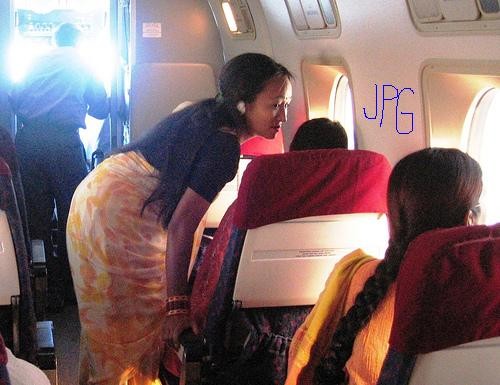
|
| |
|
|
JPEG

Please log in to subscribe to JPEG's postings.
Posted on 06-19-09 4:28
PM
Reply
[Subscribe]
|
Login in to Rate this Post:
1  ?
?  Liked by
Liked by
|
| |
Three Nepali beauties. Points to taken. Did you notice the necklace the 3 beauties are wearing. It is called "Mangalasutra" A mangalsutra (also mangala sutra or mangalasutra) is an Indian symbol of Hindu marriage, consisting of a gold ornament strung from a yellow thread, a string of black beads or a gold chain. It is comparable to a Western wedding ring, and is worn by a married woman until her husband's death. Mangalsutra is one such symbol of marriage. It is not just a jewelry item it has lots of significance to an Indian married woman. It is a sacred thread of love and goodwill worn by married women as a symbol of their marriage. The groom ties it around the neck of the bride on the day of their marriage signifying their union. It is known by different names in different states of the country.According to Hindu culture, there are five signs of marital status of women. They are mangalsutra, Toe rings, Kumkum, bangles and a nose ring. Mangalsutra is the most important among them. The word mangalsutra means an auspicious thread or cord. It is also called thaali, thaaly or maangalyam in Kannada,Tamil and thaali/maangalyam/ mangalsutram/pustelu in Telugu in Southern India. It is probably passed from South India to North India and into Nepal.

|
| |
|
|
JPEG

Please log in to subscribe to JPEG's postings.
Posted on 06-19-09 5:55
PM
Reply
[Subscribe]
|
Login in to Rate this Post:
0  ?
? 
|
| |
Saving Kusundas beauty The Kusundas are on the verge of extinction - most of us know this and it is not a pleasant fact. The Kusundas are getting ‘extinct’ - as it appears at the moment. But, there is a small hope that we could save this ethnic group of people provided we become committed and start working together, at once, for their welfare as there still live some Kusundas in the central hills of the country. And, the already ‘extinct’ Kusunda language could also be ‘revitalised’, since the Kusundas there speak their mother tongue. The Kusunda or Ban Raja ("people of the forest"), known to themselves as the Mihaq or Myahq are a tribe of former hunter-gatherers of the forests of western Nepal, who are now intermarried with neighboring peoples and settled in villages. The Nepali word Kusunda originally meant "savage", as the neighboring Chepang and other groups traditionally thought of them as savages, but the Kusunda do not mind the term when speaking Nepali. The Ban Rajas reside in Gorkha, Kaski, Rolpa, Dang, Pyuthan and Tanahu districts of Nepal. Various reports and stories have reported that Ban Rajas are currently living in these areas. According to the National Federation of Indigenous Nationalities, the Ban Rajas reside in jungles of Dhading, Gorkha, Tanahu, Kaski and Makwanpur to the districts of the Midwestern Region. According to the Nepal Population Reports 2002 the total number of Ban Rajas (Kusundas) existing are 164. Therefore Kusundas are the most endangered species of the aboriginal ethnic groups in Nepal. Points to be taken:The Kusunada language is now extinct - it is so believed. The Summer Institute of Linguistic-SIL has published a report stating the Kusunda language as extinct. An Austrian scholar Jhoan Reinhard had reported in mid-seventies that there were ‘only few speakers left alive, only two’ so he had urged to carry out a thorough research on the Kusunda language. Did Nepal's government listen to him then? The Kusunda language is supposed to be dead before being well studied and classified. Professor Bandhu has this sort of belief. The SIL has already classified this language as falling in Tibeto-Burman family. Here's some tallied few words with other Tibeto-Burman family languages having common elements in them. For example: a banana is ‘mucha’ in Kusunda, ‘mocha’ in Magar and ‘moje’ in Tamang language. Kusundas say ‘tang’ for water, Shaukas say it ‘ti’ and Magars ‘di’ - there are alveolar ‘t and d’ present in these words. Millet is called ‘mangmi’ and ‘tu’ for a snake in Kusunda and the Sherpa people say them ‘manjya’ and ‘du’ respectively. Similarly, Magars say “langha’ for village, ‘dishya’ for fish and ‘bhokta’ for clothes whereas the Kusundas say for these words ‘langhai’ , ‘nsa’ and ‘bukta’ respectively. In Tamang language a crab is called ‘kakhare’ and in Kusunda it is called ‘Kakchi- there are other words too which have some similarities with other Tibeto-Burman languages. Linguistically, these words are of great importance; on the other hand there is uncertainty whether these words could have been borrowed from any other languages. Knowing this group and saving them from extinction is the duty of every Nepalese. Of saving the Kusunda and preserving this tribal existence is the True_Beauty_of_Nepal!

|
| |
|
|
JPEG

Please log in to subscribe to JPEG's postings.
Posted on 06-20-09 8:44
AM
Reply
[Subscribe]
|
Login in to Rate this Post:
1  ?
?  Liked by
Liked by
|
| |
Rai ni beauty

|
| |
|
|
JPEG

Please log in to subscribe to JPEG's postings.
Posted on 06-20-09 10:48
AM
Reply
[Subscribe]
|
Login in to Rate this Post:
1  ?
?  Liked by
Liked by
|
| |
Limbu ni beauties. Folks here's some significants about Kirat religions which has not been incorporated into Vedic Hinduism. While worshiping of nature(snakes, stones, etc has been seen as Kirat religion being incorporated into Vedic Hinduism) which relates to Sivaism, kul puja or pitra(ancestors worship) and udhauli puja( mother worship) has escape being incorporated into Veda somehow. Here's some answers collected from Kirati elders. 1. What is Kul puja? Kul puja is the worshipping of one’s ancestors. While there are variations in kul devota worship, these activities have one thing in common. They are a means of ensuring prosperity, good fortune, and appeasing the gods and ancestral spirits. Given the importance of the rites for the well-being of the descent group, it was the social obligation of every household that possesses the necessary resources to hold kul devota worship, to sponsor the ritual activities 2. What is Udhauli puja? Udhauli puja is the worshiping of mother goddess. Udhauli means going down. It is believed that from this day the winter season starts. So people, birds and animal migrate from cold regions to warmer regions. This kind of migration occurs twice in a year. The celebration of migrating downwards during this season is called “Udhauli" and the celebration of migrating upwards during the season of Baisakh (April or May) is called “Ubhauli". This has been going on since the dawn of the mankind which time is immemorial. Still today, animals and birds migrate depending on the season. This event is also called “Bhumi Puja” (Worship of Land) where Kirat people worship mother nature asking for good cultivation of crops during the season of April( Ubhauli) when people starts to sow crops and thanking the god for giving good crops during harvesting before the cold seasons start to turn in (Udhauli). This event of Kirati people has also been stated in Mundhum (holy book of Kirati people). 3. Why do the Rais and Limbus bury their dead instead of cremating them in the ghats? It is because it is the right thing to do. The Mundhum states that “God had made your body out of the earth and ashes and today your body is mixing with the earth again.” When a male member of a family dies, his corpse should be washed and wrapped with a white shroud and put into a wooden coffin, “ Khong” and should be covered with, “Khuk” in such a way that the face of the corpse can be seen from outside. The head of the corpse should be exposed and be sheltered with a kind of cap or hat or umbrella, “Saklip”. The coffin should then be buried within a stone box under a four feet deep pit. All the mourning members who attend the burial ceremony should offer a last handful of earth to show their last respect to the dead person and the following should be chanted, “God had made your body out of the earth and ashes and today your body is mixing with the earth again.” After covering the pit with earth and stones, the grave should be piled up with four steps of stones for the man and three steps for the woman. A stone pillar should be erected in the middle of the grave. If the man is of high regard, his stone monument should be raised to eight or nine steps high in his honour. The death ritual of Kirat people is stated in Mundhum (holy book of Kirati people). 4. Why do the Rai and Limbu offer cooked meat to all at the last rites of the dead person? The cooked meat is not for the people gathered for that ritual. It is offered to the departed soul. So is wine and all kinds of food items offered. 5. Why do the Kirat people instead of incense, dry Tetepati leaves are burnt? The Tetepati leaves are from trees, and trees have been always been there since man was here on earth. That’s why Kirat are nature worshipers. 6. Why do Rais and Limbus used hot iron rod to rip the heart of pig and why do Kirat people eat pig and buffalo which are taboos to tagadharis group? The hot iron rod is the quickest, least painful and cleanest way to kill one. In early ages, Kiratis were hunters and mountaineers. They hunted animals for food with arrow and spears. Wild pigs and buffaloes thrives in the forests and plains and Kirat people have always hunted these animals. Later the pigs and buffaloes were domesticated for easier source of food. Pork is used for auspicious such as wedding and holy occasions in Rai and Limbu culture. 7. How is the marriage ritual for Rai and Limbu or of Kirat culture like? Love marriage with agreement between both partners is common. Whatever the type of marriage, however, those from the boy's side have to go with alcohol and gifts (sagun) to the girl's house and ask for their consent and offer apologies. The Rais do not marry their maternal uncle's and aunt's daughters, though there is a practice of marrying one's windowed elder sister-in-law. The main marriage ceremony takes place in the house of the groom among the Kirat's communitities which is distinctly different from the practices of the Tagadhari marriage which takes place in the bride's house. 8. I learned that some Kiratis will become ill if they happen to eat goat meat? Why is that so? It again revolves around Kul Devota and Kirateswor which is all powerful and in existence. The Kirateswor and Kul Devota have to be appeased. The Kirat communities extensively use alcohol not only in social activities but also in religious activities. 9. Why do Rais and Limbus used wild bamboo containers to store wine and jaar(millet beer)? There were no luxurious jar or glass containers to store wine and jaar(millet beer). Hence Kiratis made whatever nature gave them. Hence nature worshippers. 10. How come they don’t use all those religious offerings like other Hindus do? Kiratis are nature worshipers and they practices are simple and not complex that those of Veda religion.
Last edited: 21-Jun-09 08:48 AM

|
| |
|
|
JPEG

Please log in to subscribe to JPEG's postings.
Posted on 06-20-09 12:23
PM
Reply
[Subscribe]
|
Login in to Rate this Post:
1  ?
?  Liked by
Liked by
|
| |
Joy of celebration by Nepali beauties.
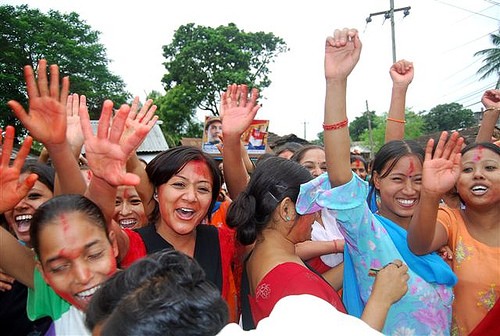
|
| |
|
|
JPEG

Please log in to subscribe to JPEG's postings.
Posted on 06-20-09 2:03
PM
Reply
[Subscribe]
|
Login in to Rate this Post:
1  ?
?  Liked by
Liked by
|
| |
Two beauty of Nepal
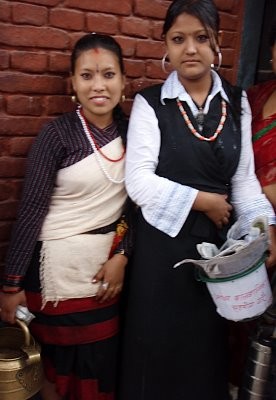
|
| |
